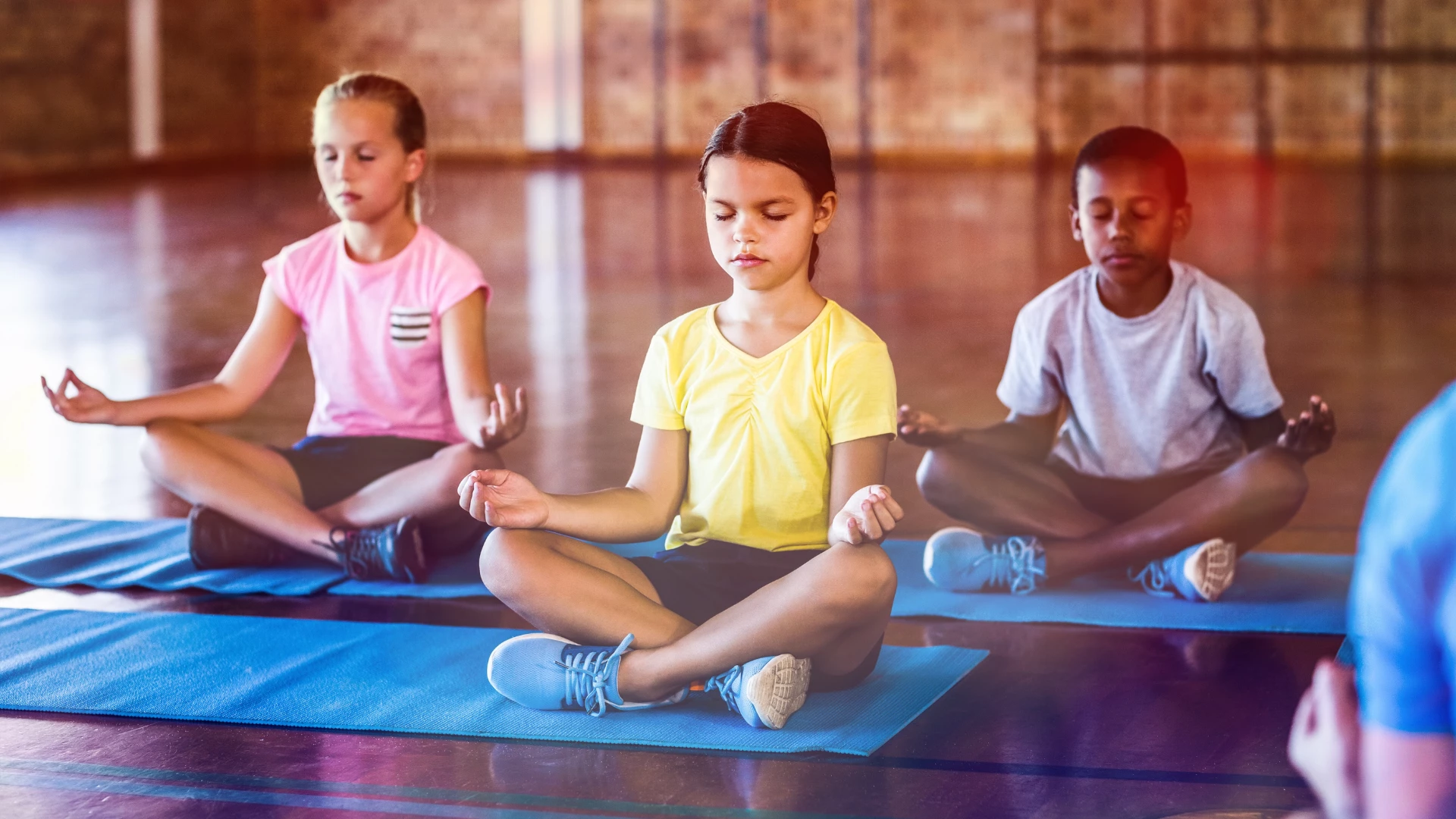Mind-Body Benefits of Yoga for Kids: What Does New Research Say?

Article At A Glance
As yoga continues to gain popularity worldwide, its benefits for adults are widely recognized. But yoga holds immense potential for children as well. More and more children are beginning to practice yoga in school, at home, or in yoga studios. What are the benefits of yoga for kids? And what does the most recent research say about it? In this article, we will explore some of the research supporting the positive impact of yoga on children’s well-being.
What are the Main Benefits of Yoga for Kids?
Yoga Can Improve Children’s Emotional Regulation
Yoga can help children learn to recognize and express their emotions appropriately and cultivate kindness toward themselves and their peers. By focusing on their breath and body sensations during yoga practice, children cultivate self-awareness, allowing them to identify and regulate their emotions more effectively. In addition, yoga promotes mindfulness, which involves being fully present in feelings and emotions at the moment without judgment.
Yoga Can Help Children Manage Anxiety
Yoga can also reduce anxiety and stress in children by teaching them how to relax their bodies and calm their minds. Teaching children how to reduce stress in a healthy way is an important life skill that will serve them well beyond childhood. The breathing exercises and relaxation techniques learned from practicing yoga can allow children to practice these techniques in a calm environment so that they can use them off the mat when they experience stress or anxiety in daily life.
Yoga Can Enhance Children’s Social Skills
In an increasingly digital world, fostering healthy social skills among children is crucial. Kids’ yoga offers a unique platform for social interaction and interpersonal growth. Yoga can promote positive social interactions among children by encouraging cooperation, communication, and respect. By encouraging collaboration and cooperation through yoga games or partner poses, yoga can also help children to practice compassion, communication, and conflict resolution.
Yoga Can Enhance Children’s Self-Esteem
Building a strong sense of self-esteem and self-worth is vital for children’s emotional well-being and personal growth. Yoga provides a non-competitive environment where children can explore and appreciate their bodies and abilities without judgment or comparison. Through regular practice, children develop a sense of achievement as they gradually master new postures and challenges, boosting their self-confidence. Additionally, the mind-body connection cultivated in yoga helps children develop a positive body image and a deeper understanding of self-acceptance.
Yoga Can Improve Children’s Attention Spans
In today’s fast-paced world, children often struggle with maintaining focus and attention. The good news is that research suggests kids’ yoga can significantly improve children’s attention span and concentration skills. Through yoga postures, breathing exercises, and mindfulness techniques, children can learn to anchor their attention to the present moment, training their minds to be more focused and alert.
What Does the Research Say About Yoga for Kids?
A growing number of studies support the benefits of yoga for children. Here are some of the most important recent findings:
Improved Attention Span in Kindergartners
In a 2019 study (1), 5-year-old kindergartners were shown to benefit from practicing yoga twice a week at school instead of regular physical education. After 12 weeks of Hatha yoga practice, children demonstrated enhanced behavior, visual-motor coordination, and cognitive performance compared to peers in standard physical education or those who did no exercise. Specifically, yoga reduced inattention and hyperactivity, improved precision task completion times, and enhanced visual attention. These findings emphasize yoga’s positive impact on children’s well-being, cognitive abilities, and academic readiness.
Health Benefits of Yoga Among Adolescents
A 2016 review (2) found that school-based yoga programs positively impacted adolescents’ health. This systematic review of school-based yoga that took place primarily in the U.S. and India highlights the growing research on the benefits of yoga for mental, emotional, physical, and behavioral health in schools. The analysis of 47 published studies reveals promising results, suggesting that yoga in school settings can effectively improve the well-being of children and adolescents. Although there were variations in intervention characteristics and study designs, the overall findings support the efficacy of yoga as a valuable strategy for enhancing student health.
Reduced Anxiety Across All Ages
A systematic review conducted in 2015 (3), which analyzed 16 research studies, concluded that yoga interventions significantly reduced anxiety among children and adolescents. Their analysis showed a consistent decrease in anxiety levels after participating in yoga that was noted across study populations. While the authors stress the need for further research is needed to generalize these findings, the study highlights the positive potential for yoga to improve the management of anxiety symptoms for school-aged children and teens.
What Are the Best Ways to Introduce Yoga to Kids?
If you’re eager to introduce yoga to the children in your life, here are some simple tips to get you started:
- Make it fun and playful: Kids—especially young ones—love games, stories, songs, and animals. You can use these elements to make yoga more engaging and enjoyable for them. For example, you can pretend to be different animals while doing the poses, sing along to kids’ songs as you practice, or create a story around a yoga sequence.
- Be flexible and adaptable: Kids have different needs, abilities, preferences, and moods. You don’t have to follow a strict routine or sequence when doing yoga with them. Instead, you can adjust the pace, duration, intensity, and difficulty of the practice according to their interest and energy level.
- Use props: A great way to engage kids is to use various items to make yoga accessible and fun. For example, you can use cozy blankets, pillows, blocks, straps, balls, stuffed animals, books, cards, or stickers. These can help them feel more comfortable, supported, and motivated to join.
- Seek out a calm space: You don’t need much space or equipment to do yoga with kids. Rather, you can practice yoga with kids in nearly any setting at any time of day. The key is to find a space and time that is safe, quiet, and convenient for you and your kids.
- Join a class or use online resources: If you are unfamiliar with yoga or want guidance, the Internet makes it easy to learn more. There are numerous articles and books out there that you can dive into that provide yoga instructions, tips, and ideas for kids.
Bringing Home the Benefits of Kids’ Yoga
The evidence from research studies overwhelmingly supports the multitude of mind-body benefits kids’ yoga offers. Through enhanced emotional resilience, improved attention span, increased self-esteem, and enhanced social skills, children can experience transformative growth that will serve them throughout their lives.
Whether you’re a yoga teacher with young students, a parent, a grandparent, or anyone else who interacts with kids, it is vital to recognize and leverage these research findings to create tailored and effective yoga programs for children. By incorporating yoga into the lives of young individuals, we can empower them with valuable tools to navigate life’s challenges, promote their mental and physical health, and lay a foundation for lifelong well-being. Together, we can use yoga to nurture the next generation.
Also, read...
Yoga In Schools Improves Health Research Shows
Feb 10 – By: B Grace Bullock, PhD, E-RYT 500
Mind-Body Benefits of Yoga for Kids: What Does New Research Say?
Aug 23 – Lacey Gibson Ramirez MSc., RYT-500, ERYT-200, RPYT, CFSD
Breath Awareness for Young Children
May 26 – By: Susan Kain, RCYT, E-RYT, YACEP
Related courses
Working with the Neurodiverse Child: Yoga for Kids with Autism & ADHD
With Shawnee Thornton Hardy
Breath as Medicine: Yogic Breathing for Vital Aging
With Doug Keller
Yoga and Myofascial Release: Releasing Chronic Tension with the Bodymind Ballwork Method
With Ellen Saltonstall

Lacey Ramirez writes for YogaUOnline and is an RYT-500 & ERYT-200 yoga teacher, global health researcher, and writer based in St. Louis. Through her work, she seeks to make yoga accessible, inclusive, and equitable.
Lacey discovered yoga as a tool for centering during her years as a competitive runner. Since then, yoga has served as a way to connect with her body throughout her experience of pregnancy and parenthood. She teaches because she hopes others can use this sacred practice for calming, healing, and transformation.
As a yoga teacher, Lacey specializes in teaching restorative, Yin, prenatal, and trauma-informed Vinyasa yoga. She has also completed birth doula and prenatal/postnatal barre certifications and trainings. Additionally, she holds a Masters of Science in Global Health and Population from Harvard T.H. Chan School of Public Health. To learn more and connect, visit her website laceyramirez.com
References:
- Jarraya, S., Wagner, M., Jarraya, M., & Engel, F. A. (2019). 12 weeks of kindergarten-based yoga practice increases visual attention, visual-motor precision and decreases behavior of inattention and hyperactivity in 5-year-old children. Frontiers in Psychology, 10, 796. https://doi.org/10.3389/fpsyg.2019.00796
- Khalsa, S. B., & Butzer, B. (2016). Yoga in school settings: a research review. Annals of the New York Academy of Sciences, 1373(1), 45–55. https://doi.org/10.1111/nyas.13025
- Weaver, L. L., & Darragh, A. R. (2015). Systematic review of yoga interventions for anxiety reduction among children and adolescents. The American journal of occupational therapy : official publication of the American Occupational Therapy Association, 69(6), 6906180070p1–6906180070p9. https://doi.org/10.5014/ajot.2015.020115
Recent articles
Fascia and the Vagus Nerve: Healing from the Inside Out
Jul 10 – Dr. Arielle Schwartz
Change Your Perspective of Pelvic Tilting: How the Transversus Abdominis Can Help
Jul 08 – Olga Kabel C-IAYT
Warrior I Pose: 5 Strengthening Variations
Jul 02 – Bridget Frederick, eRYT 500
Categories
Upcoming courses
Breath as Medicine: Yogic Breathing for Vital Aging
With Doug Keller
Yoga and Myofascial Release: Releasing Chronic Tension with the Bodymind Ballwork Method
With Ellen Saltonstall
JOIN NOW!
Recent articles
Almost there...
Sorry, we couldn't find anything...
Stress Relief
Fascia and the Vagus Nerve: Healing from the Inside Out
Have you ever had a morning in which you woke up with a painful…
Jul 10 – Dr. Arielle Schwartz
Pose Library
Change Your Perspective of Pelvic Tilting: How the Transversus Abdominis Can Help
“Tuck your tailbone under” or “lengthen your tailbone” have long been among the most…
Jul 08 – Olga Kabel C-IAYT
Yoga Practice Tips
Warrior I Pose: 5 Strengthening Variations
Warrior I Pose (Virabhadrasana I) is an excellent pose for strengthening your whole back…
Jul 02 – Bridget Frederick, eRYT 500







